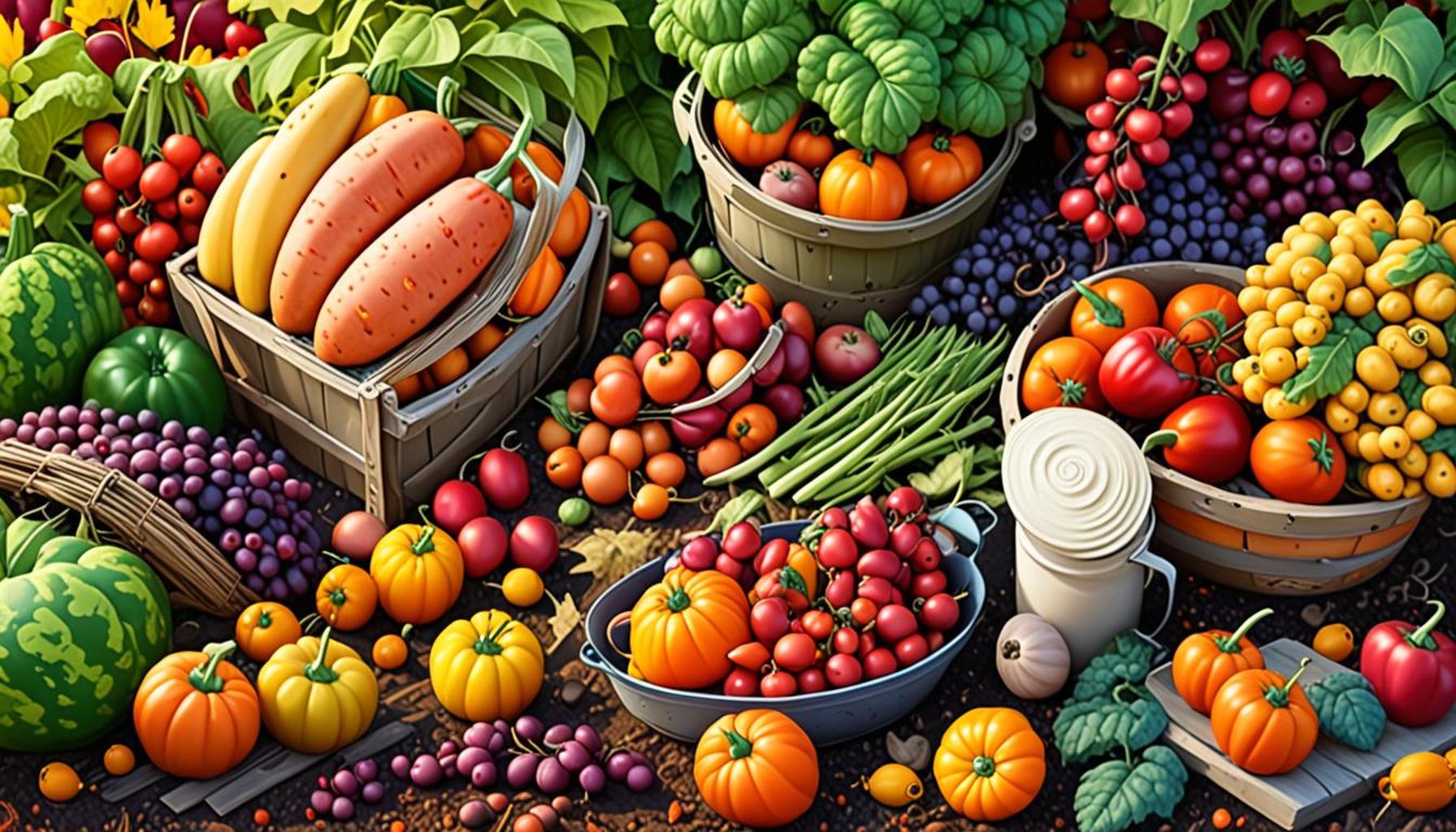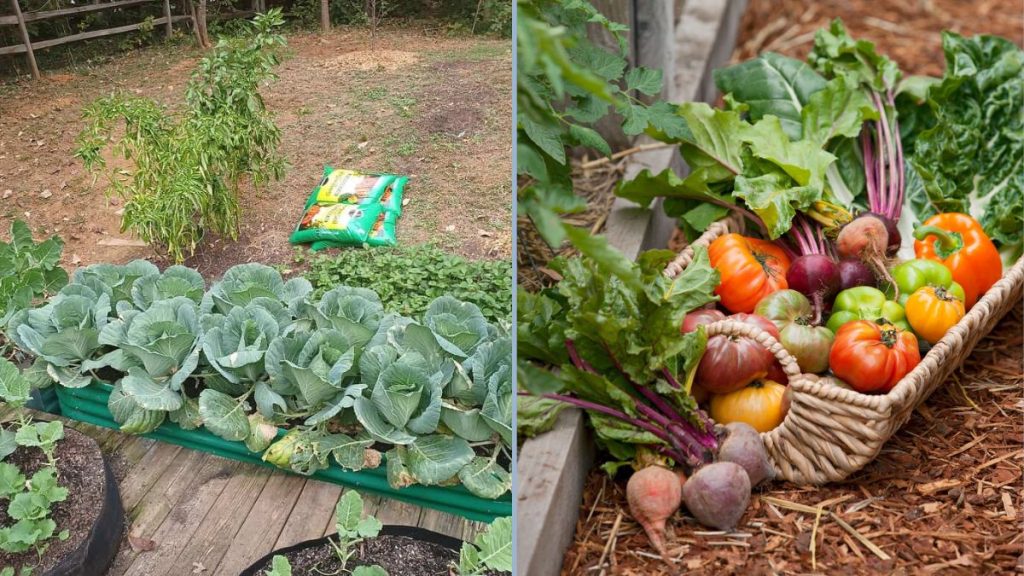Harvesting in Different Seasons: Planning Your Garden for a Continuous Supply of Fresh Food

Embracing a Year-Round Garden
Imagine stepping into your garden throughout the year and plucking ripe tomatoes, vibrant peppers, or crisp greens. With effective planning, this dream can become a stunning reality. Harvesting in different seasons is not just about growing food; it’s about creating a sustainable and continuous supply of fresh produce all year round.
Seasonal gardening expands your culinary possibilities while ensuring you reap the rich rewards of your labor. By carefully selecting what to plant and when, you can enjoy produce from your garden almost year-round. This approach not only fosters a connection to the earth but can also significantly reduce grocery bills while providing healthier eating options. Are you ready to dig in and make the most of every season’s bounty?
Understanding Your Climate
The first step to successful seasonal gardening is to understand your climate. Different regions in the U.S. have unique growing seasons based on temperature, rainfall, and frost dates. For instance, the USDA Plant Hardiness Zone Map divides the country into zones that indicate the temperature ranges suitable for various plants. Gardeners in warmer zones like the Southeast can often start planting earlier in spring and may even harvest crops in the fall, while those in the colder North must wait until after the last frost to sow their seeds.
Diverse Crop Selection
Next, consider the diversity of your crops. Choosing diverse crops ensures that your garden remains vibrant and productive throughout the year. Incorporate cool-season vegetables like kale, spinach, and broccoli in the spring and fall. These crops thrive in moderate temperatures and can handle light frosts. Conversely, warm-season delights such as zucchini, peppers, and tomatoes flourish when the weather warms up, allowing your garden to bust into color as summer arrives. Additionally, herbs like basil and rosemary can bridge the gap between seasons, enhancing flavors in your cooking while keeping your garden green.
Implementing Succession Planting
Lastly, embrace the strategy of succession planting. This technique involves sowing seeds at intervals to create a staggered supply of produce throughout the growing season. For example, if you plant a batch of lettuce every two weeks, you’ll enjoy a continuous harvest rather than a single large yield all at once. This not only maximizes your yield but also minimizes waste, encouraging you to enjoy fresh greens in salads, sandwiches, and wraps for months on end.

As you cultivate your garden with these guidelines in mind, you will discover the joys of seasonal gardening. Connecting with nature, knowing where your food comes from, and enjoying a variety of fresh produce are just a few rewards of investing the time and effort into your garden. Whether you have a small balcony or a sprawling yard, every bite from your homegrown bounty represents a step towards sustainable living.
DISCOVER MORE: Click here to learn about natural pest control methods
Planning Your Garden Layout
As you dive into the world of seasonal gardening, one of the most crucial aspects is planning your garden layout. A well-thought-out design allows you to maximize space and make the most of the variety of crops you want to grow. Successful gardeners often refer to the concept of crop rotation and companion planting, both of which contribute to a healthier and more productive garden.
Crop rotation is vital for managing soil health and preventing pest buildups. By rotating different plant families each season, you help maintain nutrient balance and reduce disease pressure. For example, if you plant beans in a particular bed one year, consider planting leafy greens, such as lettuce or spinach, in that same spot the next year. This strategy ensures that your soil remains fertile while minimizing the risk of soil-borne diseases.
Another component of effective garden planning is understanding companion planting. Some plants thrive when grown together due to benefits like pest control, improved growth rates, and better flavor. Examples include:
- Tomatoes and basil: Basil repels certain pests and enhances the flavor of tomatoes.
- Cabbage and carrots: Carrots can help aerate the soil, benefiting the cabbage’s root systems.
- Peppers and onions: Planting onions near peppers can deter pests while also maximizing yield in limited space.
Implementing these practices aids not only in producing a greater variety of crops but also in ensuring the health of your plants throughout the seasons. When planning your layout, consider using raised beds or container gardening, which can save space and provide better drainage. These options can be particularly advantageous for urban gardeners who have limited area to work with.
Sowing Seeds at the Right Time
A successful harvest hinges on sowing seeds at the right time. Each plant has its ideal planting window based on temperature and seasonality. Therefore, it’s essential to know when to start your seeds indoors versus when to sow directly into the ground. For instance, cool-season crops should be planted as soon as the soil can be worked in early spring, while warm-season crops should be introduced only after the danger of frost has passed.
To assist with timing, utilize a planting calendar specific to your region. Many gardening websites provide these tools, letting you track frost dates, optimal sowing times, and what varieties do well together. In general, starting your seeds indoors about 6 to 8 weeks before the expected last frost date can extend your growing season significantly, allowing you to transplant seedlings to the garden as soon as conditions are favorable.
With careful planning, layout, and timing, you can create a garden that doesn’t just produce food seasonally but offers an abundant supply of fresh, homegrown ingredients year-round. Embrace the endless possibilities that come with gardening, fostering a sustainable lifestyle while ensuring you savor every bite of your produce.
| Category 1 | Category 2 |
|---|---|
| Seasonal Planting | Aligning plant varieties with optimal growth seasons enhances yield. |
| Biodiversity | Incorporating diverse crops reduces pest issues and improves soil health. |
| Crop Rotation | Alternating different crops each season optimizes soil nutrient use. |
| Succession Planting | Staggering sowing dates provides a continuous harvest over months. |
One of the key features of a successful garden is understanding the concept of seasonal planting. By aligning different plant varieties with their ideal growing seasons, gardeners can significantly enhance crop yield and enjoy a wider array of fresh produce throughout the year. Moreover, incorporating biodiversity into planting strategies is crucial. Diverse crops not only combat pest infestations naturally but also contribute to improved soil health, which in turn yields healthier plants. Practicing crop rotation is another essential technique that maximizes soil nutrient use while preventing nutrient depletion typically seen with mono-cropping systems. Additionally, employing succession planting allows gardeners to stagger sowing dates, which ensures a steady supply of fresh food across multiple months, rather than a singular harvest. By embracing these methods, gardeners can effectively sustain their food supply while promoting environmental health.
DIVE DEEPER: Click here to learn about layered harvesting techniques
Extending Your Harvest with Succession Planting
To ensure a continuous supply of fresh food, gardeners can utilize the technique of succession planting. This method involves planting crops at intervals throughout the growing season, allowing multiple harvests from the same space. Instead of planting all your seeds at once, consider staggering your sowing dates to take advantage of different growth rates and seasonal conditions.
For example, you can plant a crop of radishes every two weeks throughout the spring. With this approach, you’ll not only prevent a glut of radishes all at once but will also enjoy fresh produce for a longer period. The same principle applies to leafy greens like lettuce and spinach, which can be sown in quick succession for early summer harvests. Just be aware of the temperature ranges that each type of green thrives in; many do best in cooler conditions.
Aside from greens, consider succession planting with root vegetables, such as carrots and beets, which can be planted every few weeks for staggered harvesting. This technique ensures that your garden remains productive and minimizes periods of scarcity between crops.
Embracing Seasonality with Perennial Crops
Incorporating perennial crops into your garden plan can further enhance your continuous harvest. Unlike annual plants that need to be replanted every year, perennials return season after season, providing stability and reducing planting effort over time. Examples include:
- Asparagus: A staple in spring gardens, asparagus can produce for up to 20 years once established.
- Rhubarb: This versatile plant is a great companion for fruit pies and can thrive even in cooler climates.
- Perennial herbs: Varieties such as chives, mint, and oregano can flourish year after year, adding flavor and interest to your dishes.
By incorporating these perennial crops into your plan, you can seamlessly integrate them with your annual plantings, balancing the garden’s output. This allows for a diverse array of produce, enhancing the vibrancy of your meals throughout the seasons.
Utilizing Seasonal Greenhouses and Cold Frames
If you’re situated in an area with a shorter growing season, consider investing in or building seasonal greenhouses or cold frames. These structures create microclimates that can extend your growing season significantly. They trap heat and protect tender plants from harsh weather conditions, enabling you to start your growing cycle earlier in spring and extend it into the fall.
Cold frames, in particular, can be incredibly effective in protecting young seedlings from frost, allowing you to sow crops like kale and Swiss chard earlier than you typically could. Using a greenhouse or cold frame paired with techniques like row covers can help to mitigate temperature fluctuations, thus ensuring your crops thrive despite the changing weather.
In conclusion, by employing succession planting, integrating perennials, and utilizing protective structures, you can create a dynamic and productive garden suited for harvesting throughout the year. This makes your efforts more rewarding, as you consistently gather fresh food from your garden, no matter the season.
DISCOVER MORE: Click here for essential tips on growing aromatic herbs
Conclusion
In summary, mastering the art of harvesting in different seasons is key to cultivating a garden that offers a continuous supply of fresh food. By embracing techniques such as succession planting, you can effectively coordinate your sowing to ensure that your crops are ready for harvest in a staggered manner, allowing for a steady flow of produce without overwhelming your kitchen. The integration of perennial crops not only reduces the yearly planting workload but also provides a dependable source of vegetables and herbs season after season.
Furthermore, creating additional growing environments with seasonal greenhouses and cold frames can significantly extend your growing season, which is particularly beneficial for gardeners in northern climates facing shorter summers. By investing in these protective structures, you can enhance your garden’s productivity, ensuring that tender plants flourish even in challenging weather conditions.
Ultimately, the joy of gardening lies in the diverse flavors and nutritional benefits it brings to your table throughout the year. Whether you’re savoring the fresh crispness of spring salads or the hearty flavors of winter root vegetables, planning for a year-round harvest fosters not just a thriving garden, but a deeper appreciation for the food you cultivate. As you expand your gardening knowledge and practices, you pave the way for a rewarding journey filled with sweet harvests and bountiful delights.



